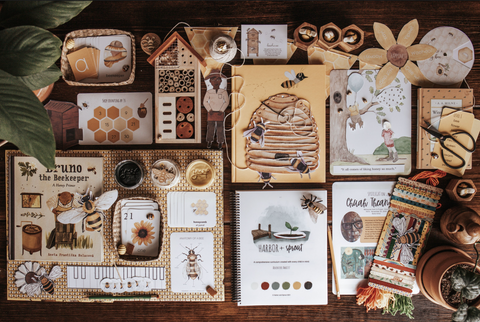
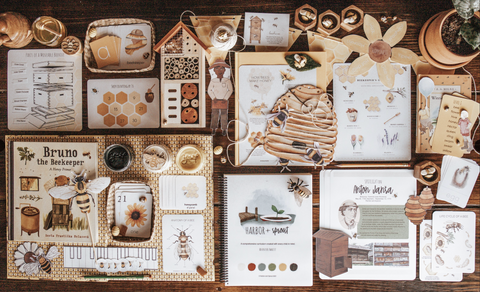


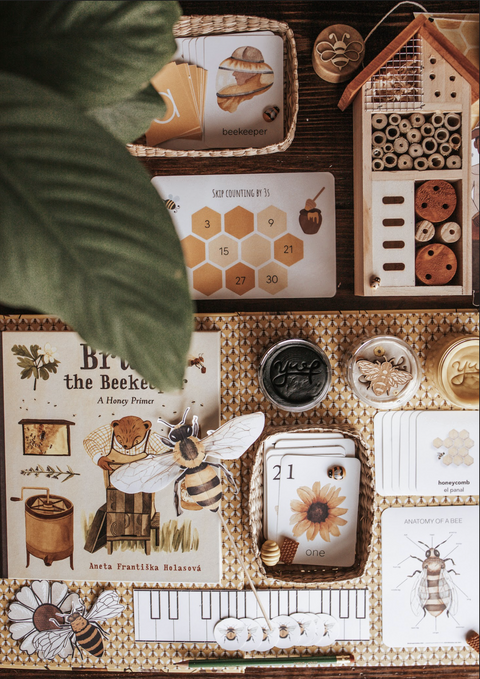
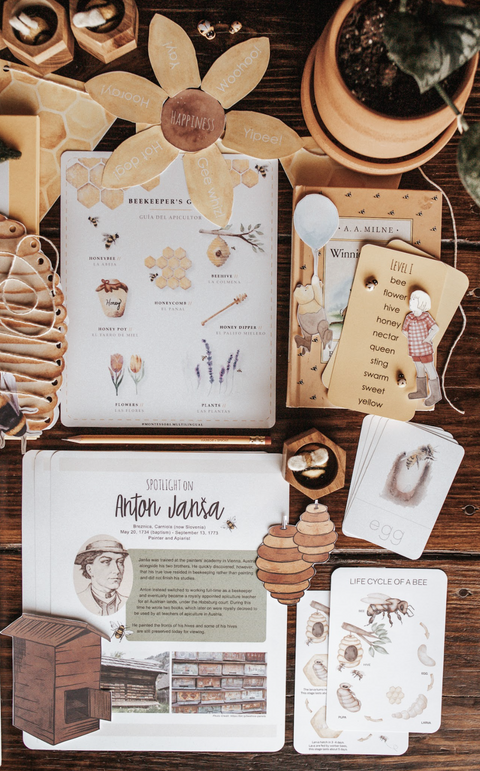
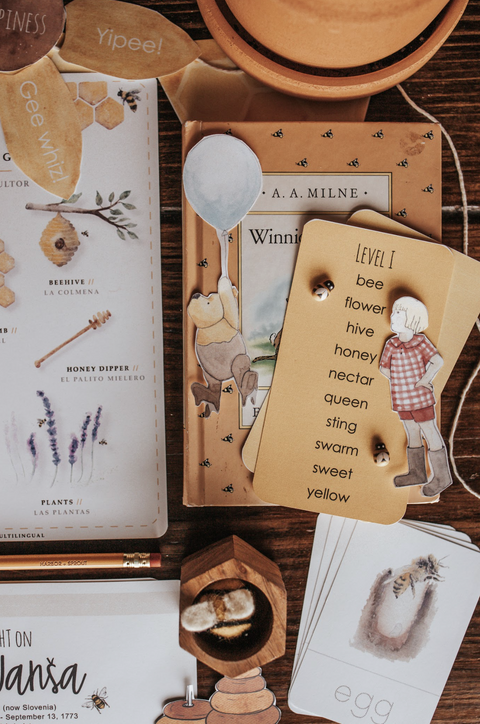

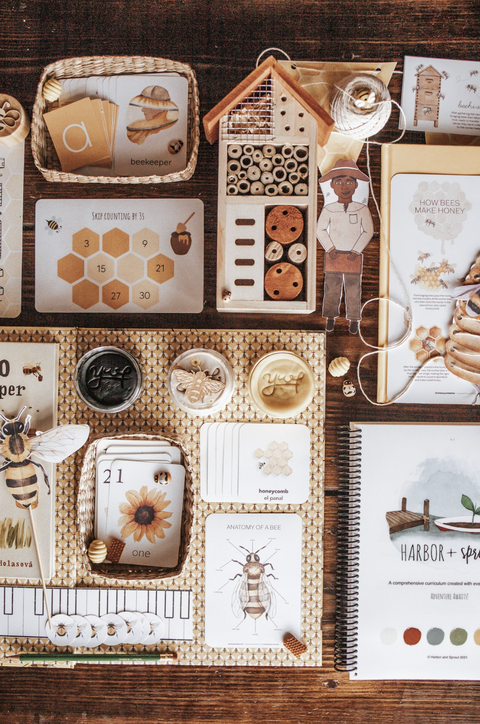

Harbor and Sprout
Beekeeping Patchwork Study
Welcome to the Harbor + Sprout Beekeeping Patchwork Study, originally released April 2022 and updated January 2025. This elementary-level unit study features 4 weeks of lesson plans and materials covering all 9 of our core subjects and a playful supplemental section of thematic activities. This unit study is meant for use by children ages 3-12.
This unit is delivered via a secure link as a digital download. Shop our corresponding Morning Basket Pack by Rebecca Clarke of Whimsy Printables here!
CONTENT:
Handbook
Daily, weekly, and monthly planning pages
Booklist including stories, poems, and field guides with recommended ages, subject correspondence, and brief summaries for each title
Lesson plans for 4 levels of learning
Family read aloud recommendations
Character kit- new monthly character illustrated by Stephanie Groves to act as your guide through the unit
Unit Recipe
Supply List
Science
Lesson 1: What is Beekeeping? In this lesson, you will explore different types of beehives, essential beekeeping practices, and the amazing products bees create. You will make a straw skep, identify key beekeeping tools, and build a solar wax melter.
Lesson 2: What are the Bees' Unique Abilities? In this lesson, you will discover the world of different types of bees, their anatomy, and their unique abilities. You will label the parts of a bee, make special glasses to see like a bee, and experience how bees sense electric fields.
Lesson 3: What are the Virtues of Honey? In this lesson, you will explore the diverse types of honey, their traditional uses, and their well-being benefits. You will enjoy a honey tasting session, experiment with honey fermentation, and explore its crystallization process.
Lesson 4: Why and How to Protect Bees? In this lesson, you will discover the vital role bees play in biodiversity and how to create a bee-friendly garden. You will study bee routes, observe how temperature affects them, and experiment with pollination.
Nature Study
Lesson 1: Honey Bee Identification- In this lesson, you will learn how to identify honey bees and spot their look-alikes, record bee observations in your new Bees Nature Journal, play a spot it game, and extend your learning by comparing honey bees to bumblebees.
Lesson 2: Honey Bee Vision- In this lesson, you will learn how honey bees work and their ability to see the invisible, conduct a bee color experiment, design the best flower to attract the most bees, and make honey playdough and bee-vision glasses.
Lesson 3: Honey Bee Communication- In this lesson, you will learn how honey bees tell each other where the best flowers are, play a game that will have you “talking like a bee”, and observe forager bees in the wild and make a Bee Flower Suncatcher.
Lesson 4: Honey Varieties- In this lesson, you will learn how the type of flowers a bee collects nectar from changes the color and flavor of honey produced and extend your learning with your reading of the poem “Song of the Bees” by Hannah Flagg Gould.
Language Arts
Lesson 1: Winnie - the - Pooh- In this lesson, you will explore the world of Winnie-the-Pooh and Some Bees which is the very first story in a collection of children’s stories about this fictional, friendly, honey-loving teddy bear named Winnie-the-Pooh.
Lesson 2: Interjections- In this lesson, you will understand the function of interjections and be able to use them in a sentence. You will also learn that honey bees make a “whoop” noise when they are startled much like when humans.
Lesson 3: Anthropomorphism- In this lesson, you will understand the meaning and purpose of anthropomorphism in storytelling. It can be a powerful tool in triggering emotions from readers which is one of the main reasons authors use it.
Lesson 4: Puns- In this very “punny” lesson, you will learn to understand puns and be able to create your own. You will watch and/or read examples of puns and explore how puns are used to make jokes or notes that could brighten someone’s day.
Writing
Lesson 1: Plan- In this lesson, you will begin creating your very own children’s fictional picture book. You will explore picture book characteristics, start with a brainstorm, and create the characters, setting, and conflict of your story.
Lesson 2: Write- In this lesson, you will continue creating your picture book by outlining and writing your first draft. You will consider plot structure and briefly outline the beginning, middle, and end of your story. Then you will write your story.
Lesson 3: Revise & Storyboard- In this lesson, you will continue creating your picture book by editing, proofreading, and storyboarding. You will read through your draft several times looking for mistakes, ways to improve, and finally to decide illustrations.
Lesson 4: Illustrate- In this lesson, you will finalize your picture book by writing a final draft on the book pages provided, using your favorite art medium to illustrate your story, design your book cover with title, and finally bind your book with staples, string, etc.
History
Lesson 1: Honey Stealing- In this lesson, you will explore the history of honey stealing using literature, study “Stealing Honey from Honey Bees”, and investigate why people would steal honey as you learn about the amazing properties of honey.
Lesson 2: Beekeeping in Ancient Egypt- In this lesson, you will study the history of beekeeping in ancient Egypt and how that has shaped our knowledge of bees today. You will learn a little about their habits, living conditions, and how the people treated and interacted with them.
Lesson 3: History of Beehives- In this lesson, you will learn about the skep, log hive, box hive, and moveable frame beehive. You will consider the growing concern regarding the population of honeybees and how inventions are helping protect them.
Lesson 4: Indigenous Honey Bees- In this lesson, you will discover locations that are native to honey bees, learn how honey bees spread to non-native continents, and imagine what the world would be like if honey bees didn’t exist on every continent.
Geography
Lesson 1: Bolivia- In this lesson, you will explore the culture of the South American country of Bolivia. You will learn various facts about the country, its national anthem in Spanish and English, what the flag looks like, and so much more!
Lesson 2: Maps- In this lesson, you will familiarize yourself with the continent and oceans of the world and the country of Bolivia. You will be able to locate many bodies of water and land masses on the world map and country map.
Lesson 3: Bolivia: Land of Diversity- In this lesson, you will learn about Bolivian land and culture, including elevation, wildlife, diversity, and art. You will dive deeper into Andean textile art, the talented indigenous women who produce it, and its vibrant colors and patterns.
Lesson 4: Bees in Bolivia- In this lesson, you will explore ways to help save the bees, including planting flowers, allowing for wild/natural growth, create a bee pond, buy local produce, and “bee” a friend to and advocate for the bees.
Music
Lesson 1: Bee Friendly Music- In this lesson, you will first put yourself in a garden to listen to the sounds of nature around you. Then you will explore the sounds bees use to communicate with one another and how to attract bees back into our own gardens.
Lesson 2: Wing Music & Percussion Sounds- In this lesson, you will discover the percussive sound made simply by the movement of a bee’s wings, how they make that sounds, and what that sound means. You will explore different kinds of percussion instruments.
Lesson 3: Sweet as Honey: Tonality- In this lesson, you will discover that Western music splits tonality into two types: major and minor. You will dive deeper into scales, musical alphabet, whole and halftones, sharps, flats, and so much more.
Lesson 4: Bee Happy- In this lesson, you will combine music with your whole mind and body. You will practice bee yoga, learn about accidentals and the symbols used to indicate those changes, and listen to the famous “Flight of the Bumblebee.”
Art
Lesson 1: Hexagonal Patterns- In this lesson, you will learn a little about the life and work of Anton Jansa, esteemed painter and beekeeper, and explore the fascinating how and why bees make their honeycombs in hexagonal shapes.
Lesson 2: Tactile Process Art- In this lesson, you will explore the nesting habits of bees, the lifecycle of honeybees, the life and work of Mexican-American artist Roberto Benavidez, and the characteristics and benefits of tactile art for young children.
Lesson 3: Exploring Batik- In this lesson, you will discover a style of wax-resist dyeing on cloth called Batik which originated in Indonesia, how culturally important this art is, and learn about the life and work of Chuah Thean Teng or “the Father of Batik.”
Lesson 4: Mixed Media Collages- In this lesson, you will explore collage-based art, the life and work of Eric Carle (beloved children’s book author and illustrator), sculpture with recycled materials, mandalas and how to create them, and a mixed media self-portrait.
Math
Lesson 1: Busy Bee Shapes- In this activity, you will practice shape identification and matching, shape tracing, and shape name tracing. As an extension, you will practice drawing, labeling, researching, and reporting of shapes and their characteristics.
Lesson 2: Busy Bee Counting Games- In this activity, you will practice tracing numbers 1-20, counting to 10, operations practice (including addition, subtraction, multiplication, and division), and skip counting by 2s, 3s, 4s, 5s, 6s, 7s, 8s, 9s, and 10s.
Lesson 3: Number Bonds- In this activity, you will practice number bonds. You will explore the different ways to break down a number, strengthening your addition skills, number sense, and knowledge of number families.
Lesson 4: Sum Flowers- In this activity, you will practice your addition skills by calculating the sum of letters of each flower. You will use a decoding sheet to assign a numerical value to each letter and an A-Z flashcards to identify the flowers,
Supplement
Nature Activities
Anatomy of a Bee Activity
Bee Alphabet Letter Cards
Bee Coloring Sheets
Bee Memory Game
Bee Number Cards
Bee Tangram Puzzle
Flying Bee Puppet
How Bees Make Honey
Life Cycle of a Bee Pack
Life of Bees Cards
Thematic and Bilingual Activities
Bee Joke Book
Beekeeper Notes Pun Cards
Beekeeper's Guide (Spanish)
Bee Royalty Crown Templates
Writing & Language Arts
Beekeeping Vocabulary
Spelling Bee
Word Searches
B is for Bee
Beekeeping Copy Work
Bee Poetry
Writing Reference Pages
Spelling Puzzles and Cards
This unit will be delivered digitally as a downloadable zip file. H+S Patchwork Studies average approximately 550-650 pages of content. While the download does include the option to print the full unit straight through front and back, we recommend printing on an as-needed, as-you-go basis. Enjoy your adventure with the bees!
